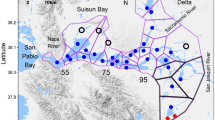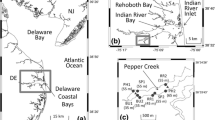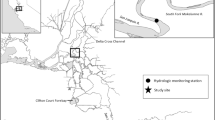Abstract
Development in the southeastern US coastal plain generates the need for a better understanding of how survival and abundance of estuarine nekton respond to urbanization. Apparent survival and density of the dominant Atlantic coast salt marsh fish, the mummichog Fundulus heteroclitus, were estimated in four North Carolina tidal creeks using a model simultaneously fitted to mark-resight and mark-recapture data. Rates of weekly loss (mortality plus emigration) were high (~ 10%). Sampling for tagged fish within and outside of study creeks showed high site fidelity to each creek, indicating that loss largely resulted from mortality rather than emigration. Estimated rates of apparent survival were lowest in the creek with the least instream- and watershed-level impacts. This creek has direct (non-culvert) access downstream to a larger waterbody, suggesting that enhanced access by predators and/or greater rates of permanent emigration may have contributed to lower apparent survival in this creek. There was a positive relation between minnow trap catch-per-unit-effort (CPUE) and density allowing the relationship between CPUE and habitat and urbanization to be examined in a total of six creeks. The largest CPUE estimates occurred early in each growing season and were associated with creeks possessing characteristics most representative of undisturbed salt marsh mosaics: high percentage of marsh coverage instream and downstream and high percentage of marsh edge. Given generally limited movement outside of creeks, differences in abundance among creeks likely result from different levels of recruitment that are related to salt marsh availability. Priority preservation of salt marsh habitats may be warranted by natural resource planners to maintain abundance levels of this trophically important species.








Similar content being viewed by others
References
Able, K.W. 1999. Measures of juvenile fish habitat quality: examples from a national estuarine research reserve. Pp. 134–147 in L.R. Benaka (ed.): Fish habitat; essential fish habitat and rehabilitation. American Fisheries Society Symposium 22, Bethesda, MD.
Able, K.W. and M.P. Fahay. 1998. The first year in the life of estuarine fishes in the mid-Atlantic Bight. Rutgers University Press, New Brunswick, N.J., 342 p.
Able, K.W., D.N. Vivian, G. Petruzzelli, and S.M. Hagan. 2012. Connectivity among salt marsh habitats; residency and movements of the mummichog (Fundulus heteroclitus). Estuaries and Coasts 35 (3): 743–753.
Allen, D.M., S.S. Haertel-Borer, B.J. Milan, D. Bushek, and R.F. Dame. 2007. Geomorphological determinants of nekton use of intertidal salt marsh creeks. Marine Ecology Progress Series 329: 57–71.
Bacheler, N.M.C.M. Schoberand, Z.H. Schoberand, W.A. Mitchell, D.J. Berrane, G.T. Kellison, and M.J.M. Reichert. 2013. Comparison of trap and underwater video gears for indexing reef fish presence and abundance in the Southeast United States. Fisheries Research 143: 81–88.
Bailey, N.T.J. 1951. On estimating the size of mobile populations from capture-recapture data. Biometrika 38 (3-4): 293–306.
Barker, R.J. 1997. Joint modeling of live-recapture, tag-resight, and tag-recovery data. Biometrics 53 (2): 666–677.
Beck, M.W., K.L. Heck Jr., K.W. Able, D.L. Childers, D.B. Eggleston, B. Gillanders, B. Halpern, C. Hays, K. Tisthammer, T.J. Minello, R. Orth, P.F. Sheridan, and M. P. Weinstein. 2001. The identification, conservation, and management of Estuarine and Marine Nurseries for fish and invertebrates. BioScience 51: 633–641, 8.
Begon, M. 1979. Investigating animal abundance: capture-recapture for biologists, 97. London: Edward Arnold Publishers.
Boesch, D.F., and R.E. Turner. 1984. Dependence of fishery species on salt marshes: the role of food and refuge. Estuaries 7 (4): 460–468.
Bretsch, K., and D.M. Allen. 2006. Effects of biotic factors on depth selection by salt marsh nekton. Journal of Experimental Marine Biology and Ecology 334 (1): 130–138.
Brewer, M.B., P.J. Rudershausen, B.D. Sterba-Boatwright, J.H. Merrell, and J.A. Buckel. 2016. Survival, tag retention, and growth of spot (Leiostomus xanthurus) and mummichog (Fundulus heteroclitus) following PIT tag implantation. North American Journal of Fisheries Management 36 (3): 639–651.
Cicchetti, G. 1998. Habitat use, secondary production, and trophic export by salt marsh nekton in shallow waters. Dissertation. The College of William and Mary, Williamsburg, Virginia, 276 p.
Cormack, R.M. 1964. Estimates of survival from the sighting of marked animals. Biometrika 51: 429–438.
Craft, C., J. Clough, J. Ehman, S. Joye, R. Park, S. Pennings, H. Guo, and M. Machmuller. 2009. Forecasting the effects of accelerated sea-level rise on tidal marsh ecosystem services. Frontiers in Ecology and the Environment 7 (2): 73–78.
Dame, R., M. Alber, D. Allen, A. Chalmers, R. Gardner, C. Gilman, B. Kjerfve, A. Lewitus, M. Mallin, C. Montague, J. Pinckney, and N. Smith. 2000. Estuaries of the South Atlantic coast of North America: their geographical signatures. Estuaries 23 (6): 793–819.
Deaton, A., S. Chappell, and K. West. 2006. Process for identification of strategic habitat areas in coastal North Carolina. North Carolina division of marine fisheries. NC: Morehead City 55 p.
Deegan, L.A., D.S. Johnson, R.S. Warren, B.J. Peterson, J.W. Fleeger, S. Fagherazzi, and W.M. Wollheim. 2012. Coastal eutrophication as a driver of salt marsh loss. Nature 490 (7420): 388–392.
Donnelly, J.P., and M.D. Bertness. 2001. Rapid shoreward encroachment of salt marsh cordgrass in response to accelerated sea-level rise. Proceedings of the National Academy of Sciences 98 (25): 14218–14223.
Eberhardt, A.L., D.M. Burdick, and M. Dionne. 2011. The effects of road culverts on nekton in New England salt marshes: implications for restoration. Restoration Ecology 19 (6): 776–785.
Escofier, B., and J. Pagés. 1994. Multiple factor analysis (AFMULT package). Computational Statistics and Data Analysis 18 (1): 121–140.
Everitt, B.S. 1992. The analysis of contingency tables. Vol. 168. 2nd ed. New York: Chapman and Hall/CRC.
Garside, E.T., and Z.K. Chin-Yuen-Kee. 1972. Influence of osmotic stress on upper lethal temperatures in the cyprinodontoid fish Fundulus heteroclitus (L.). Canadian Journal of Zoology 50 (6): 787–791.
Garside, E.T., and G.C. Morrison. 1977. Thermal preferences of mummichog, Fundulus heteroclitus, and banded killifish, Fundulus diaphanus (Cyprinodontidae) in relation to thermal acclimation and salinity. Canadian Journal of Zoology 55 (7): 1190–1194.
Gelman, A. 1996. Inference and monitoring convergence. In Markov chain Monte Carlo in practice, ed. W.R. Wilks, S. Richardson, and D.J. Spiegelhalter, 131–143. London: Chapman and Hall.
Gelman, A., H.L. Meng, and H.S. Stern. 1996. Posterior predictive assessment of model fitness via realized discrepancies (with discussion). Statsticia Sinica 6: 733–807.
Gittman, R.K., S.B. Scyphers, C.S. Smith, I.P. Neylan, and J.H. Grabowski. 2016a. Ecological consequences of shoreline hardening: a meta-analysis. Bioscience 66 (9): 763–773.
Gittman, R.K., C.H. Peterson, C.A. Currin, F.J. Fodrie, M.F. Piehler, and J.F. Bruno. 2016b. Living shorelines can enhance the nursery role of threatened estuarine habitats. Ecological Applications 26 (1): 249–263.
Hargrove, J.W., and C.H. Borland. 1994. Pooled population estimates from mark-recapture data. Biometrics 50 (4): 1129–1141.
Hettler, W.F., Jr. 1989. Nekton use of regularly flooded saltmarsh cordgrass habitat in North Carolina, USA. Marine Ecology Progress Series 56: 111–118.
Hewitt, D.A., E.C. Janney, B.S. Hayes, and R.P. Shively. 2010. Improving inferences from fisheries capture-recapture studies through remote detection of PIT tags. Fisheries 35 (5): 217–231.
Hinrichsen, D. 1998. Coastal waters of the world: trends, threats, and strategies, 275. Washington, D.C.: Island Press.
Holland, A.F., D.M. Sanger, C.P. Gawle, S.B. Lerberg, M.S. Santiago, G.H.M. Riekerk, L.E. Zimmerman, and G.I. Scott. 2004. Linkages between tidal creek ecosystems and the landscape and demographic attributes of their watersheds. Journal of Experimental Marine Biology and Ecology 298 (2): 151–178.
Husson, F., J. Josse, S. Le, and J. Mazet. 2018. Package ‘FactoMineR.’ Available at: https://cran.r-project.org/web/packages/FactoMineR/FactoMineR.pdf
Jensen, C.C., L.S. Smart, and A.S. Deaton. 2014. Strategic habitat area nominations for region 3: the White Oak River basin in North Carolina (final report). North Carolina Division of Marine Fisheries. NC: Morehead City 123 p.
Jolly, G.M. 1965. Explicit estimates from capture-recapture data with both death and dilution-stochastic model. Biometrika 52 (1-2): 225–247.
Kennish, M.J. 2001. Coastal salt marsh systems in the U.S.: a review of anthropogenic impacts. Journal of Coastal Research 17: 731–748.
Kéry, M. 2010. Introduction to WinBUGS for ecologists: a Bayesian approach to regression, ANOVA, mixed models and related analyses. Vol. 302. Amsterdam: Academic Press.
Kéry, M., and M. Schaub. 2012. Bayesian population analysis using WinBUGS: a hierarchical perspective. Vol. 535. Amsterdam: Academic Press.
Kneib, R.T. 1986. The role of Fundulus heteroclitus in salt marsh trophic dynamics. American Zoologist 26 (1): 259–269.
Kneib, R.T. 1997. The role of tidal marshes in the ecology of estuarine nekton. Oceanography and Marine Biology: An Annual Review 35: 163–220.
Kneib, R.T. 2002. Salt marsh ecoscapes and production transfers by estuarine nekton in the Southeastern United States. In Concepts and controversies in tidal marsh ecology, ed. M.P. Weinstein and D.A. Kreeger, 267–291. Dordrecht: Springer.
Kneib, R.T., and A.E. Stiven. 1978. Growth, reproduction, and feeding of Fundulus heteroclitus (L.) on a North Carolina salt marsh. Journal of Experimental Marine Biology and Ecology 31 (2): 121–140.
Kneib, R.T., and A.H. Craig. 2001. Efficacy of minnow traps for sampling mummichogs in tidal marshes. Estuaries 24 (6): 884–893.
Krebs, J.M., C.C. McIvor, and S.S. Bell. 2014. Nekton community structure varies in response to coastal urbanization near mangrove tidal tributaries. Estuaries and Coasts 37 (4): 815–831.
Leamon, J.H., E.T. Shultz, and J.F. Crivello. 2000. Variation among four health indices in natural populations of the estuarine fish, Fundulus heteroclitus (Pisces: Cyprinodontidae), from five geographically proximate estuaries. Environmental Biology of Fishes 57 (4): 451–458.
Lotrich, V.A. 1975. Summer home range and movements of Fundulus heteroclitus (Pisces: Cyprinodontidae) in a tidal creek. Ecology 56 (1): 191–198.
Lowe, M.R., and M.S. Peterson. 2014. Effects of coastal urbanization on salt-marsh faunal assemblages in the northern Gulf of Mexico. Marine and Coastal Fisheries: Dynamics, Management, and Ecosystem Science 6 (1): 89–107.
Lowe, M.R., and M.S. Peterson. 2015. Body condition and foraging patterns of nekton from salt marsh habitats arrayed along a gradient of urbanization. Estuaries and Coasts 38 (3): 800–812.
Lyons, J.E., W.L. Kendall, J.A. Royle, S.J. Converse, B.A. Andres, and J.B. Buchanan. 2016. Population size and stopover duration estimation using mark-resight data and Bayesian analysis of a superpopulation model. Biometrics 72 (1): 262–271.
McCarthy, M.A. 2007. Bayesian methods for ecology. Cambridge University Press, Cambridge, England, 306 p.
Meredith, W.H., and V.A. Lotrich. 1979. Production dynamics of a tidal creek population of Fundulus heteroclitus (Linnaeus). Estuarine and Coastal Marine Science 8 (2): 99–118.
Meyer, D.L., and M.H. Posey. 2014. Isolated salt marsh colonization by a resident species, mummichog (Fundulus heteroclitus) and a transient species, pinfish (Lagodon rhomboides). Journal of Experimental Marine Biology and Ecology 460: 197–210.
Minello, T.J., K.W. Able, M.P. Weinstein, and C.G. Hays. 2003. Salt marshes as nurseries for nekton: testing hypotheses on density, growth, and survival through meta-analysis. Marine Ecology Progress Series 246: 39–59.
Mudd, S. 2011. The life and death of salt marshes in response to anthropogenic disturbance of sediment supply. Geology 39 (5): 511–512.
Nichols, J.D., J.E. Hines, and K.H. Pollock. 1984. Effects of permanent trap response in capture probability on Jolly-Seber capture-recapture model estimates. The Journal of Wildlife Management 48 (1): 289–294.
North Carolina Division of Marine Fisheries. 2010. Research needs identified by the North Carolina coastal habitat protection plan. North Carolina Division of Marine Fisheries, Morehead City, NC, 19 p.
Partyka, M.L., and M.S. Peterson. 2008. Salt marsh communities in an anthropogenic landscape: characterizing the stationary habitat mosaic along an estuarine gradient. Journal of Coastal Research 24: 1570–1581.
Plummer, M. 2015. JAGS version 4.0.0 user manual. Available at: http://freebsd.csie.nctu.edu.tw/distfiles/mcmc-jags/jags_user_manual.pdf
Pollock, K.H., J.D. Nichols, C. Brownie, and J.E. Hines. 1990. Statistical inference for capture- recapture experiments. Wildlife Monographs 107: 1–97.
R Development Core Team. 2011. R: a language and environment for statistical computing. R Foundation for Statistical Computing, Vienna.
Raimondi, P.T., and D.C. Reed. 1996. Determining the spatial extent of ecological impacts caused by local anthropogenic disturbances in coastal marine habitats. In Detecting ecological impacts: concepts and applications in coastal habitats, ed. R.J. Schmitt and C.W. Osenberg, 179–188. San Diego: Academic Press.
Roling, J.A., L.J. Bain, and W.S. Baldwin. 2004. Differential gene expression in mummichogs (Fundulus heteroclitus) following treatment with pyrene: comparison to a creosote contaminated site. Marine Environmental Research 57 (5): 377–395.
Royle, J.A. 2008. Modeling individual effects in the Cormack-Jolly-Seber model: a state-space formulation. Biometrics 64 (2): 364–370.
Rudershausen, P.J., J.A. Buckel, T. Dubreuil, M.J. O’Donnell, J.E. Hightower, S.J. Poland, and B.H. Letcher. 2014. Estimating movement and survival rates of a small saltwater fish using autonomous antenna receiver arrays and passive integrated transponder tags. Marine Ecology Progress Series 499: 177–195.
Rudershausen, P.J., J.A. Buckel, M.A. Dueker, S.J. Poland, and E.F. Hain. 2016. Comparison of fish and invertebrate assemblages among variably altered tidal creeks in a coastal landscape. Marine Ecology Progress Series 544: 15–35.
Rudershausen, P.J., J.H. Merrell, and J.A. Buckel. 2018. Fragmentation of habitat affects communities and movement of nekton in salt marsh tidal creeks. Marine Ecology Progress Series 586: 57–72.
Sandercock, B.K. 2003. Estimation of survival rates for wader populations: a review of mark-recapture methods. Bulletin-Wader Study Group 100: 163–174.
Sanger, D., A. Blair, G. DiDonato, T. Washburn, S. Jones, G. Riekerk, E. Wirth, J. Stewart, D. White, L. Vandiver, and A.F. Holland. 2015. Impacts of coastal development on the ecology of tidal creek ecosystems of the US southeast including consequences to humans. Estuaries and Coasts 38 (S1): 49–66.
Schaub, M., and J.A. Royle. 2014. Estimating true instead of apparent survival using spatial Cormack-Jolly-Seber models. Methods in Ecology and Evolution 5 (12): 1316–1326.
Seber, G.A.F. 1965. A note on the multiple-recapture census. Biometrika 52 (1-2): 249–259.
Skinner, M.C., S.C. Courtenay, W.E. Parker, and R.A. Curry. 2005. Site fidelity of mummichogs (Fundulus heteroclitus) in an Atlantic Canadian estuary. Water Quality Research Journal of Canada 40 (3): 288–298.
Smith, G.M., and J.S. Weis. 1997. Predator-prey relationships in mummichogs (Fundulus heteroclitus (L.)): effects of living in a polluted environment. Journal of Experimental Marine Biology and Ecology 209 (1-2): 75–87.
Stierhoff, K.L., T.E. Targett, and P.A. Grecay. 2003. Hypoxia tolerance of the mummichog: the role of access to the water surface. Journal of Fish Biology 63 (3): 580–592.
Street, M.W., A.S. Deaton, W.S. Chappell, and P.D. Mooreside. 2005. North Carolina Coastal Habitat Protection Plan. North Carolina Department of Environment and Natural Resources, North Carolina Division of Marine Fisheries, Morehead City, NC, 656 p.
Su, Y-S, and M. Yajima. 2015. Package ‘R2jags.’ Available at: https://cran.rproject.org/web/packages/R2jags/R2jags.pdf
Sweeney, J., L. Deegan, and R. Garritt. 1998. Population size and sire fidelity of Fundulus heteroclitus in a macrotidal salt marsh creek. Biological Bulletin 195 (2): 238–239.
Teo, S.L.H., and K.W. Able. 2003. Habitat use and movement of the mummichog (Fundulus heteroclitus) in a restored salt marsh. Estuaries 26 (3): 720–730.
Underwood, A.J., and C.H. Peterson. 1988. Towards an ecological framework for investigating pollution. Marine Ecology Progress Series 46: 227–234.
Valiela, I., J.E. Wright, J.M. Teal, and S.B. Volkmann. 1977. Growth, production, and energy transformations in the salt marsh killifish Fundulus heteroclitus. Marine Biology 40 (2): 135–144.
Van Veld, P.A., and D.E. Nacci. 2008. Toxicity resistance. In The toxicity of fishes, ed. R.T. Di Giulio and D.E. Hinton, 597–641. Boca Raton, FL: CRC Press.
Wannamaker, C.M., and J.A. Rice. 2000. Effects of hypoxia on movements and behavior of selected estuarine organisms from the southeastern United States. Journal of Experimental Marine Biology and Ecology 249 (2): 145–163.
Weis, J.S., J. Samson, T. Zhou, J. Skurnick, and P. Weis. 2001. Prey capture ability of mummichogs (Fundulus heteroclitus) as a behavioral biomarker for contaminants in estuarine systems. Canadian Journal of Fisheries and Aquatic Sciences 58 (7): 1442–1452.
Williams, B.K., J.D. Nichols, and M.J. Conroy. 2001. Analysis and management of animal populations: Modeling estimating and decision making. Vol. 817. San Diego: Academic Press.
Acknowledgments
We thank M.A. Dueker, J.H. Merrell, and S.J. Poland for their help in collecting and compiling fish and habitat data as well as computations of watershed imperviousness. C. Pelletier, K. Moore, and C. Hoffman helped collect movement and fidelity data. This article was greatly improved by the comments of three anonymous reviewers as well as reviews by B. Mosher and J.M. Carter (US Geological Survey). K. Pollock made valuable suggestions and contributions to the overall model.
Funding
This work was funded by North Carolina Sea Grant Award # R/10-HCE-1.
Author information
Authors and Affiliations
Corresponding author
Ethics declarations
Disclaimer
Any use of trade, firm, or product names is for descriptive purposes only and does not imply endorsement by the US Government.
Additional information
Communicated by Mark S. Peterson
Appendices
Appendix 1
Model code fitted through Bayesian inference in R and JAGS softwares used to simultaneously fit three sub-models within a Bayesian framework to study Fundulus heteroclitus in tidal creeks in coastal North Carolina. The three sub-models were as follows: (a) a hierarchical formulation of the Cormack-Jolly-Seber (CJS) model to estimate apparent survival (“phi”) and detection probability (“p”), (b) an ad hoc formulation of the Lincoln-Petersen (LP) method to estimate abundance (\( \hat{N_i} \)) and density, and (c) two different models (linear model and asymptotic model) for examining the relation between minnow trap catch-per-unit-effort (CPUE) and density.



Appendix 2
Rights and permissions
About this article
Cite this article
Rudershausen, P.J., Hightower, J.E., Buckel, J.A. et al. Survival and Density of a Dominant Fish Species Across a Gradient of Urbanization in North Carolina Tidal Creeks. Estuaries and Coasts 42, 1632–1653 (2019). https://doi.org/10.1007/s12237-019-00575-5
Received:
Revised:
Accepted:
Published:
Issue Date:
DOI: https://doi.org/10.1007/s12237-019-00575-5




